Mendi (Hindi म) - the painting by the body of henna. Unlike the tattoo is a temporary decoration of the body, but it keeps much longer (up to three weeks) rather than paint or other ways of drawing through the body. The most common in Arab countries, India, North Africa and Indonesia.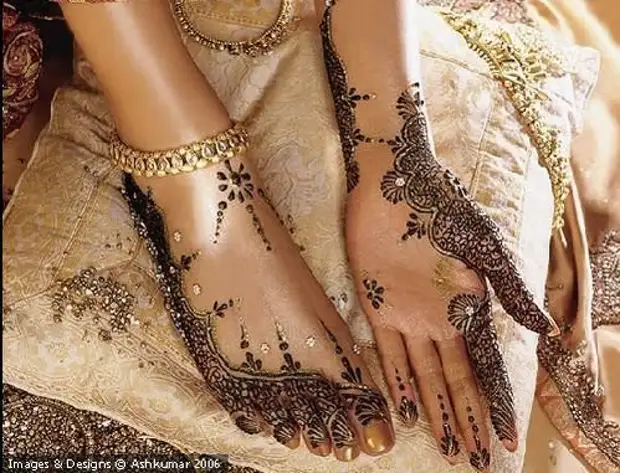
Traditional painting
Mendi appeared about 5,000 years ago. Even in ancient Egypt, noble ladies decorated their body and nails with a drawing. In the XII century, she secured in India, becoming not only an ornament. For example, many Arab women believe that Mendi brings happiness and protects against failures. So during the wedding, the bride is painted with a pattern, and the remaining henna burst into the ground to protect the marriage and avoid the infidelity of her husband.
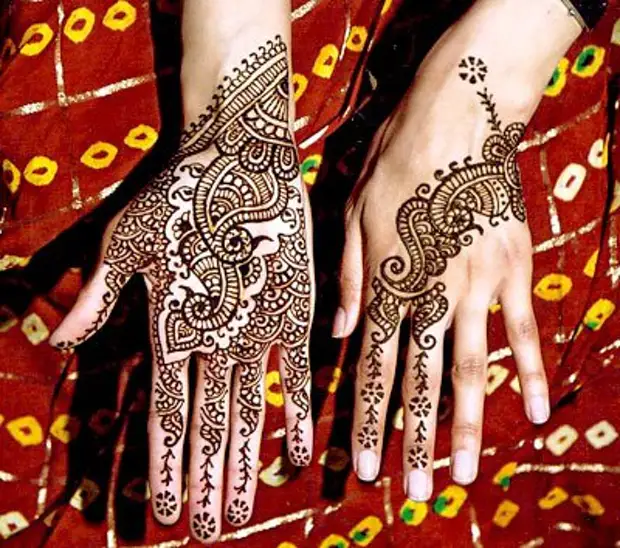
Traditional motifs differ greatly depending on the region:
- North Africa. The drawing is very stylized. Special attention is paid to the application and clarity of contours.
- Middle East. Vegetable patterns characteristic of Arab culture. Budnice drawing is simple, complex patterns are carried out mainly to ceremonies. Bedouins living in the desert, often just dip the feet and palms in Henna, without any decor.
- India. Basically, the temple dancers or solemn ceremonies are mainly carried out, mainly to the weddings. Pretty complex and large (cover the area from the palms to the forearm and from the feet to the knees) lace drawings. Basically depict religious motifs and fertility signs.

- Indonesia. The vegetable Indian motifs are used. There are fully painted pillows of fingers, side ports of palms and stop.
Mendi came to Europe preferably recently. This is largely due to the poor attitude of the Christian church to the joy of the flesh and the fact that Henna spoils very quickly. However, now the painting on the body of henna begins to gain popularity due to the fact that quite many famous singers and actresses, such as Madonna, Naomi Kermbolel, Demi Moore, are covered with the drawings of Henna.
Modern painting option -
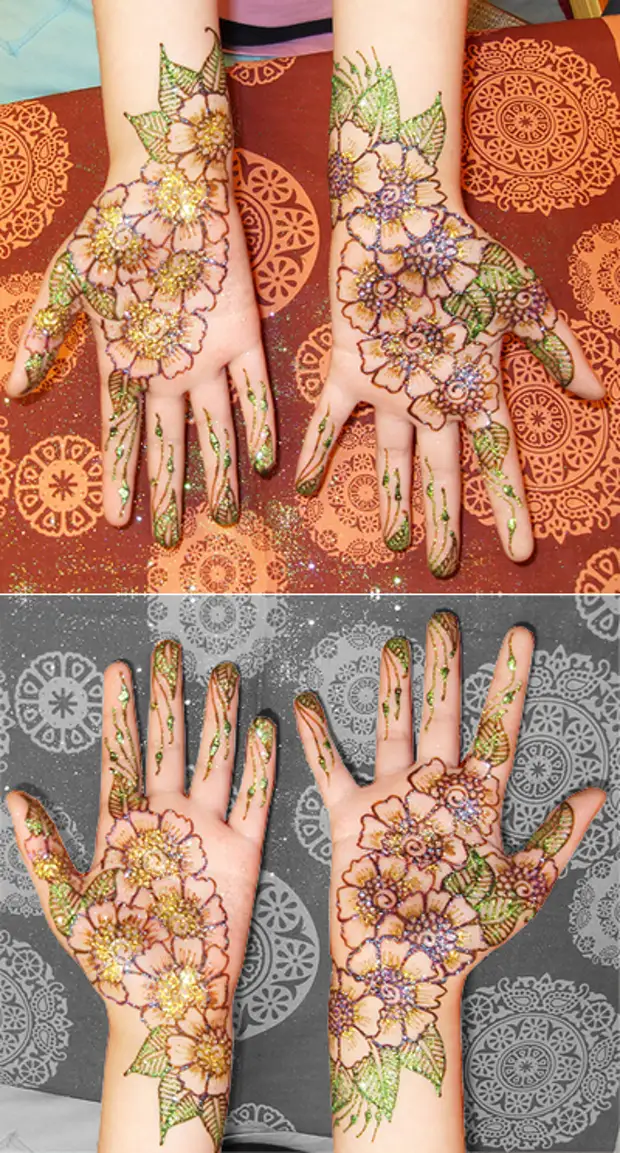
Painting
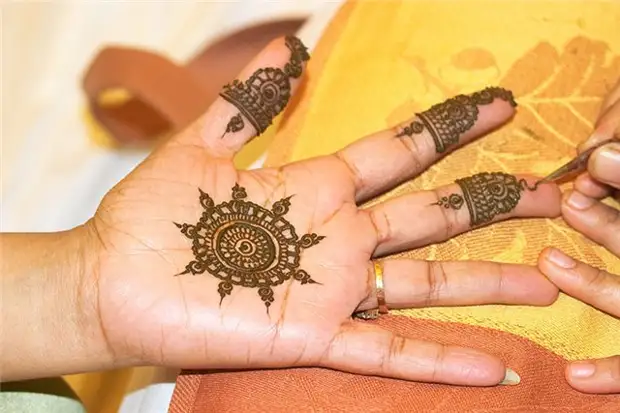
In Europe, there are quite a few salons that can offer a henna body painting service for 10-50 €, depending on the complexity and size of the picture. In Russia, such a service is much less common, but the drawing can be made independently by reading the manual.
Paint recipes
The color of the paint depends on the recipe.- Dissolve 30-40 grams of pure henna powder in 500 ml of hot water.
- Dissolve 30-40 grams of pure henna powder in 500 ml of hot water. After boiling water, add 2 teaspoons of ground coffee and black tea. Cook for an hour. Strain.
- Dissolve 30-40 grams of pure henna powder in 250 ml of hot water. After boiling water add 250 ml of red wine.
- Dissolve 30-40 grams of pure henna powder in 500 ml of hot water. After boiling water, add 2 teaspoons of sugar and lemon juice.
- Dissolve 30-40 grams of pure henna powder in 500 ml of hot water. After boiling water, add 5 tablespoons of clover and soar on low heat for 20 minutes.
To apply drawings on the hands-legs, you need a henna paste:
- For one part of ordinary sugar, add 3-4 parts of the henna powder.
- Add a heated (warm) lemon juice, (coffee, wine, vinegar or any acid drink), it should be added to add a little, thoroughly mixing and breaking lumps.
- The paste must be somewhat more dense than necessary, it looks like a potato mashed potatoes, after which the paste should be closed with polyethylene, serving it to the surface of the henna, not leaving the air layer.
- Put in the dark and warm place. Suppose from 3 to 12 hours.
- After that, add to the paste, gradually, essential oils (eucalyptus, for a more rich color is recommended, Tea Tree oil Teatree Oil) to the desired thickness, add a bit of lemon juice and leave, cover as before polyethylene, for the next 1-12 hours.
Remember, the paste should not be very thick, whatever you can sell it through the cockles, but sufficiently thick enough to not spread on the surface of the skin. The paste need to be placed in plastic coolers, having cut the corner. Finished paste, it is better to store in the refrigerator. If you are planning a long storage, put the paste in the freezer.
Skin preparation
Place of drawing is preferably before drawing to deflect the alcohol. Locking into the skin about three droplets of eucalyptus oil will make the pattern more durable and will avoid irritation.
Application
Traditionally, the pattern is applied fine metal or wooden wand, you can also use a brush, syringe-firing or buy finished huhu in a tube. Newbies can use stencils. Before drawing a henna pattern can be felt-tipped.Remember, Henna is a strong dye, so you immediately remove the excess paint outside the pattern with a stick moistened in alcohol.
Drying
After applying the paint for 6-8 hours, it should dry, after which the remaining paint should be carefully erased with a cloth or scrape a nail. Dry paint is best under the sun or infrared lamp. The pattern will hold longer if the paint during drying is moistened with a mixture of 2 tablespoons of lemon juice and a tablespoon of sugar (for example, applying an exhaled napkin.
After applying
Do not be afraid that the drawing immediately after applying bright orange. After 24-48 hours, the pattern will be the usual dark cinnamon. Up to this time, you need to avoid contact with water pattern. Durable Figure will make wipes with oil within 2-3 days after application. The place where the pattern is applied, it is better not to rub and not to wash, but only it is easy to rinse with water. The painting of the henna disappears slowly, within 2-3 weeks gradually bleaching.Advice
- Graphite mixed with paint, make a drawing more dark.
- Brighter the patterns on the hands and footsteps are obtained.
- (Stop mural option:
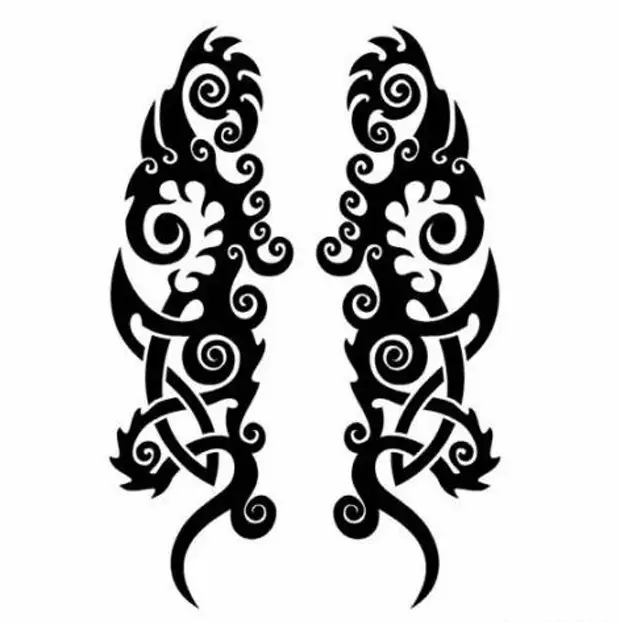
Problems
If your paste does not leave a fairly clear mark Perhaps she did not have a sufficient amount of time. The paste must draw quite a long time (up to 12 hours) so that the dye can sufficiently stand out. Another probability is problems with the skin surface. Lotions, sweat, moisture, skin fat, can weaken the penetration of the dye into the skin. Before applying paste on the skin, wipe it with alcohol, or degrease in another way. Also make sure that the paste is applied to the skin and not "hanging" on her hair.If your paste dries too fast and cracks , add a little more sugar or honey, it will help the paste to be more plastic and while drying is dried, and it will also be kept on the surface of the skin. Also, do not forget to apply a solution of sugar and lemon juice (1: 1) on top of a slightly filtered pattern, it will help keep the paste wet longer, and the dye is better absorbed into the skin.
If your drawing disappears too fast . Leave the paste on the skin as long as possible. The longer the paste on the skin, the deeper penetrates the dye. Another probability is your drawing too often in contact with water and detergent. Chlorinated water, in the pools also contributes to the fastest "burnout" of paint. If your skin is too dry, you can make a drawing with essential oil once a day. Also before wetting the drawing with water (taking baths, shower ...) Lubricate it with essential oil.
Also, problems may arise due to improper storage of the finished paste. Must keep it in a cold, dry place, say, in the refrigerator.
Allergy to hen
Henna itself does not cause allergies, however, paraphenylenediamine (PPD) is added to it in her paint, which can cause contact dermatitis when redness appears, rash, skin edema. Henna drawing can cause and hypersensitivity to PPD.
To avoid allergies, try to use only natural huhu without adding synthetic substances. Before drawing, apply a small amount of henna in the ear and over the reaction for 72 hours.
Indian, classic experience
Before applying the pattern on the skin, the hen is bred by warm water until the formation of a homogeneous mass of the sour cream-like consistency. Often, strong tea, coffee, red wine, tincture of walnuts are used as a solvent. Sugar, lemon juice, eucalyptus oil are added to the mixture.The quantitative ratio of ingredients largely determines the intensity of the painting pattern. Usually managers take as much as necessary to perform the pattern. A The mixture is prepared no earlier than 30 minutes before the procedure is performed.
In India, the recipes for tattooing henna are traditional and transmitted from generation to generation. Below is a recipe of one of these compositions.
Prepare a strong welding of tea (the tone of the drawing depends on its fortress) and they spill it into two identical containers. One part of the welding is connected to juice squeezed out of half of the lemon, and sugar (2 tbsp. Spoons) and breed the henna powder obtained. As a result, a mass of consistency is thick sour cream.
The resulting paste is maintained for 15-20 minutes, then shift it into a device for applying patterns and proceed to work. Divorced by Welding Hub can be stored in a cool place (preferably in the refrigerator) 24-48 hours.
Before working the skin on the selected body section, they degrease or make a light peeling, and then rubbing eucalyptus oil (it increases the character drying time, allowing Henna to interact with the skin, enhancing the intensity of the color).
Then a syringe, a bag or a tuba fill henna and make a drawing on the prepared area of the skin. As a rule, the paste from the henna is laid out with a layer in 2-, but the thicker, the pattern it turns out more and more durable, and its color is more intense.
The character of the henna on the body is usually performed by arbitrarily from the hand, much less often use special stencils (in this case, the drawing is applied to the film, we still put the wet to the skin and double-edge the imprint of the puzzle from the henna). As the henna dry (approximately every 20-30 minutes), the drawing is moisturized with a cotton swab dipped in a natural lemon juice or concentrated citric acid (juice can be used in a mixture with olive oil, sugar and crushed garlic) - this ensures more intense color of the tattoo And her durability.
As a rule, the henna paste dries over 2 hours, after which it is scraped. Over the next 24 hours, the pattern is not recommended to wet water.
The exact following the described drawing technology allows you to achieve a great result when tattooing the henna. It should be noted that immediately after drying and removing the paste. The drawing is not clear enough, it has a light yellow-brown color. He stands to upset about this, because for the next day it becomes darker and bright.
What to do if the henna does not leave you traces .... and really want!
... on the skin of some people natural henna does not give the desired effect. In this case, the billatoo can be made using a special chemical composition, called black henna. It is a white powder, which is bred in front of the use of cold water to the consistency of thick sour cream.
The technology of applying a pattern on the black henna body is very simple: the skin on the selected area is degreasing or made light peeling, then treated with a helium deodorant and translate with a special pencil or copy paper.
After that, in contours of the figure, they apply a layer in 2-diluted with water chemicals and leave it to complete drying. The remains of black henna are removed with a paper or tissue napkin.
A source
